Crystal LaBeija: Iconic Drag Queen Who Established House System

Crystal LaBeija reacts on stage to losing the Miss All-America title in New York City in the 1968 documentary, “The Queen.” (Source)
Updated August 7, 2024
Published on March 22, 2023 ~ By Shari Rose
As a Black drag queen in the 1960s, Crystal LaBeija combated racism in the drag scene by founding the house system, a staple of ballroom culture today, and establishing the House of LaBeija
Crystal LaBeija was a Black drag queen whose famous outburst caught on film during a racially divided drag competition in the late 1960s paved the way for her to contribute more to drag culture than shade and fabulous outfits. By creating the House of LaBeija, the first house of its kind, she founded the house system as we know it today and forever changed queer culture long after her death. Considering the deeply divisive politics and restrictive social norms of her time, Crystal LaBeija demonstrated how finding one’s chosen family is all the more critical as laws criminalizing drag queens, transgender people, and the entire LGBTQ+ community become normalized.
- Late 19th Century Drag Ball Culture in Harlem
- Criminalization of Drag Queens & Ballroom Culture
- Drag Queen Crystal LaBeija Enters the Scene
- The Queen Documentary Follows Miss All-America Contest
- Crystal LaBeija Speaks Out After Losing to Rachel Harlow
- Crystal Establishes the House of LaBeija
- Importance of House System in LGBTQ+ Community
- Pepper LaBeija Takes Over as House Mother
- Crystal LaBeija’s Death and Legacy
Late 19th Century Drag Ball Culture in Harlem
Drag balls have a long history in the United States, stretching back to 1869 when the first ball was hosted at the Hamilton Lodge in Harlem. Because they were deemed indecent and immoral by mainstream society, these lavish spectacles were largely planned in secret by gay, transgender, and queer New Yorkers. Drag balls brought together hundreds of LGBTQ+ folks, and involved mostly Black and Latinx patrons.
The ballroom scene was pure LGBTQ+ underground culture at its core. At these parties, queer men, women, and nonbinary folks were free to dance together and be their authentic selves, even if just for an evening. Drag queens typically dressed in elegant and formal fashions, lesbians often wore masculine clothing, and many gay men dressed in feminine clothing. These drag balls offered the opportunity to dance, drink, and be merry, all the while safe in the company of other queer people.
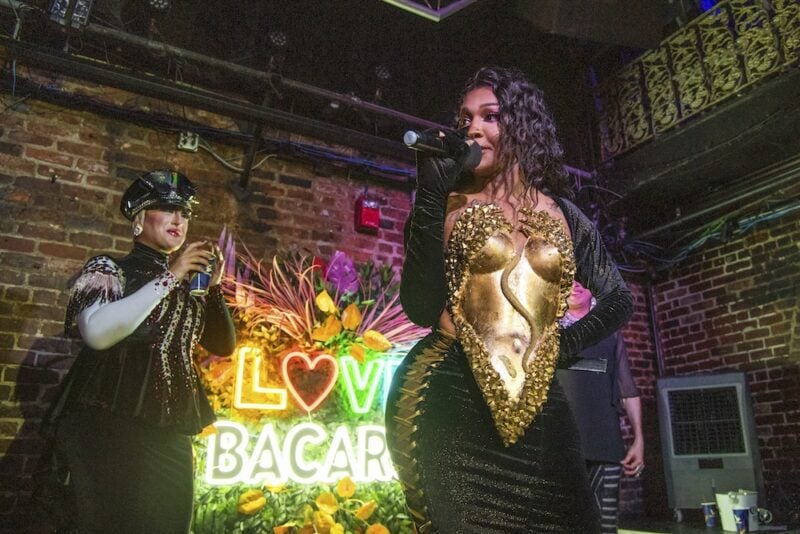
In an example of a modern drag ball, A’keria C. Davenport performs at Tales of the Cocktail at Bacardi Drag Ball on July 25, 2022, in New Orleans. (Photo by Amy Harris/Invision/AP)
Drag balls reached the height of its popularity during the Harlem Renaissance, 40 years before Crystal LaBeija entered the scene, in the 1920s. Harlem was a hotbed of underground queer culture, and these drag balls were the epicenter of the joy, debauchery, and spectacle that queer Black and Latino locals enjoyed in the city. But the growing popularity caught the attention of state lawmakers who sought to criminalize drag balls and queer activity altogether.
Criminalization of Drag Queens & Ballroom Culture
Similarly to the onslaught of drag queen bans and criminalization of transgender people that right-wing politicians are currently engaging in the 2020s, lawmakers sought similar bans 100 years ago. In 1923, the New York state legislature passed a series of laws that made “homosexual solicitation” illegal. This effectively made hosting or attending drag balls a criminal act.

New York ballroom patrons pose in the 1990 documentary, “Paris Is Burning.” (Source)
However, queer organizers found workarounds for the new ballroom laws. They learned that local neighborhoods friendly to their cause could apply for a “police sponsorship” in the area they wanted to host a drag event, and this loophole worked for many years. But during the restrictive Prohibition Era in the early 1930s, politicians and police renewed their interest in criminalizing queer people. Cops targeted drag balls and gay bars throughout New York City, often relying on entrapment strategies to convince patrons to commit illegal acts before making arrests.
But despite the best efforts of police and lawmakers, drag balls continued on in secret, and picked up steam once again as gay soldiers returning from WWII settled in New York. In the 1940s and 1950s, drag balls attracted thousands of participants and audience members to their events. Black, Latinx, and white drag queens competed in integrated events and contests, and local celebrities were often members in the audience.
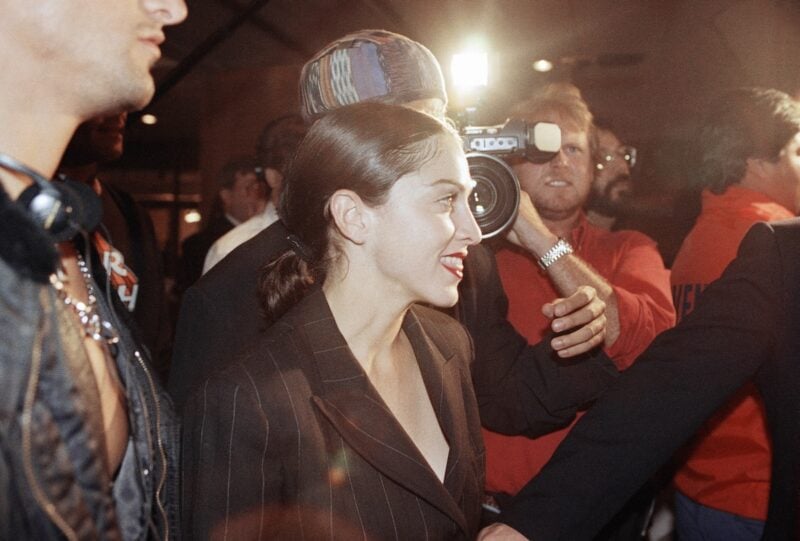
Madonna arrives for the premiere benefit of “Paris Is Burning” in Beverly Hills, CA on Aug. 8, 1991. The proceeds from the premiere of the documentary benefited the AIDS project in Los Angeles. (AP Photo/Craig Fujii)
In the early 1960s, however, racial tensions began to divide drag queens. This is the era that Crystal LaBeija made her debut on the drag scene.
- More stories: Lucy Hicks Anderson: Black Transgender Pioneer of the 1940s
- More stories: Zazu Nova’s Legacy at the Stonewall Riots
- More stories: How Stetson Kennedy Infiltrated the KKK & Changed the Jim Crow South
Drag Queen Crystal LaBeija Enters the Scene
Crystal LaBeija was a Manhattan-based drag queen who spent a few years working her way through New York City’s drag contests. She gained prominence as a queen who wore lavish furs and had an uncanny ability to strike iconic poses on stage. Originally using the stage name, “Crystal LaAsia,” she changed her name to “LaBeija” in recognition of what Latina drag queens nicknamed her, “La Belleza,” or “Beauty.”
As a Black drag queen in the 1960s, LeBeija faced intense pressure to lighten her complexion with makeup to give herself a better chance of winning drag competitions. With racial divisions in the U.S. widening further, Black and Latina queens were expected to whiten their faces if they wanted the chance to outscore their white counterparts.
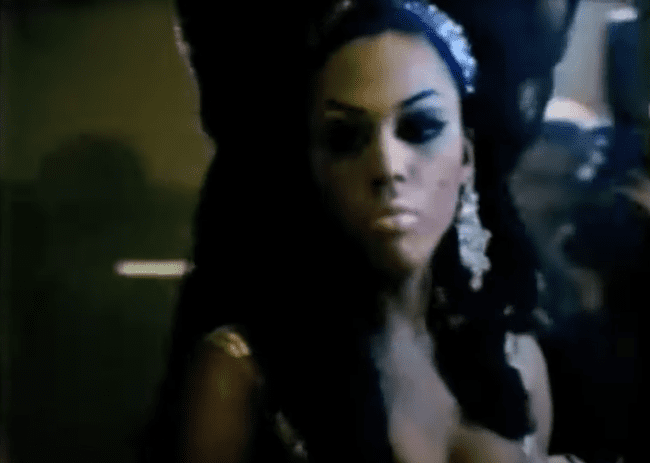
LaBeija struts on stage while competing for the 1967 Miss All-America Camp Beauty Pageant. (Source)
After spending years competing in the drag circuit, LaBeija won the “Miss Manhattan” title in a drag race hosted by white organizers. It was exceedingly rare for a drag queen of color to win such a competition, and this new title allowed her to compete in larger pageants. Unbeknownst to her, Crystal LaBeija’s legacy in modern queer culture began when she competed in the 1967 Miss All-America Camp Beauty Pageant.
The Queen Documentary Follows Miss All-America Contest
The Miss All-America Camp Beauty Pageant was held at New York City’s Town Hall in February 1967. It brought together the best drag queens in the region to compete for a highly coveted title, and even boasted Andy Warhol, Larry Rivers, and George Plimpton as judges. The event was partly organized by Flawless Sabrina, a white drag queen who also served as emcee.
A 1968 film documentary titled, The Queen, closely follows the contest and its participants. Dressed in lavish gowns with multiple costume changes, immaculate makeup, and polished hairstyles, drag queens performed dance and pose routines on stage to a delighted audience. Drawing on the influences from the ballroom scene in 1920s Harlem, queens spared no expense in putting their best foot forward for the opportunity to be crowned Miss All-America.
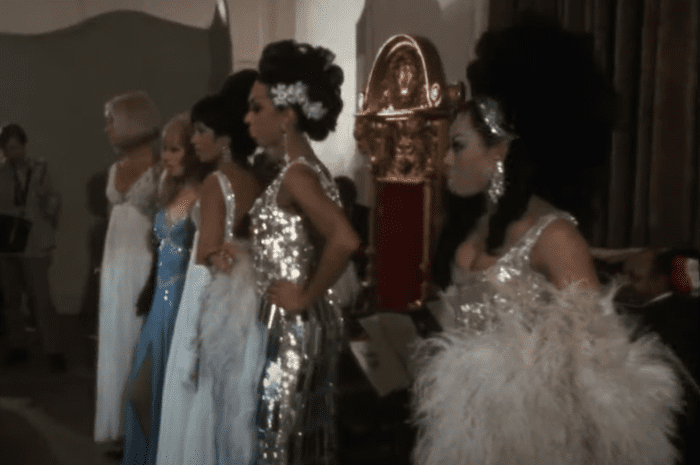
Crystal LeBeija (right) stands alongside other drag queen finalists in the 1967 contest in New York City. (Source)
Near the end of the competition, LaBeija was named a finalist along with four other queens. She wore a sparkly white gown with gorgeous furs, bedazzled earrings that nearly reached her shoulders, and a big hairstyle reflective of the Swinging Sixties.
As captured by The Queen documentary, Crystal LaBeija was named 3rd runner-up, placing 4th overall. The judges determined Rachel Harlow, a white and blond-haired drag queen, the winner of the Miss All-America Camp Beauty Contest.
Indignant at the loss and aware of the racial influences that affected the judges’ decision, LaBeija walked off stage.

The iconic moment when LaBeija walked off stage captured by “The Queen” documentary. (Source)
Emcee Flawless Sabrina did not hide her surprise at the act. These moments, immortalized on film by The Queen, capture LaBeija’s dramatic exit from the stage.
“Crystal, where are you going?” Flawless Sabrina asked. “This is not a time to show temperament. Get back here and stay with the other finalists.”
The documentary crew found LaBeija elsewhere in the building, and the queen did not mince her words about Rachel Harlow’s crowning achievement.
“…it’s bad publicity for Harlem and all the rest because I declare her one of the uglier people of the world!” LaBeija said.
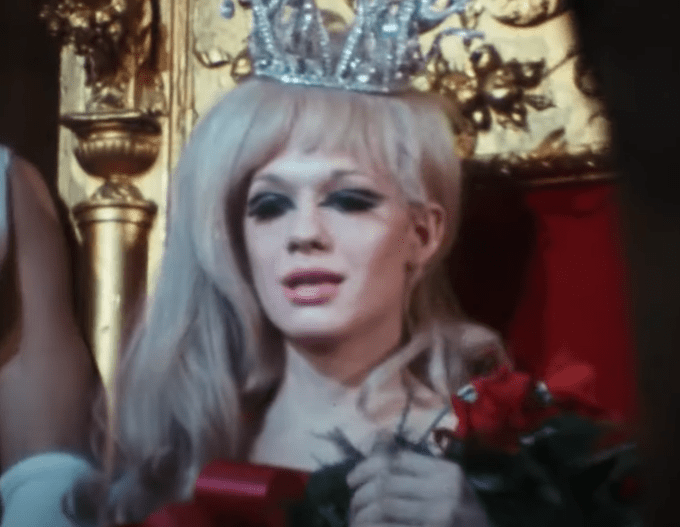
Rachel Harlow is crowned Miss All-America. (Source)
She then went on to threaten to sue Sabrina, who LaBeija believed had rigged the competition in favor of Harlow, because the young winner was Sabrina’s protégée.
“[Sabrina] won’t make money off of my name, darling,” LaBeija said to The Queen documentary crew. “She can make it off her alone and all the rest of the fools that will flock to her. But not Crystal, darling.”
Crystal LaBeija Speaks Out After Losing to Rachel Harlow
Once backstage with the other queens, Crystal LaBeija found Flawless Sabrina and stayed on the offensive. In the confrontation, she told Sabrina, “The judges didn’t have any taste, it was with you that the judges were with, darling.”
When someone in the room commented that LaBeija was showing her color, the drag queen delivered her famous line: “I have a right to show my color, darling. I’m beautiful and I know I’m beautiful.”

Crystal LeBeija rails against the pageant results and calls out Flawless Sabrina while backstage. (Source)
Though LaBeija told the other contestants to not bother the winner because “it’s not Harlow’s fault. It’s not her fault,” LaBeija went on to point out that Rachel Harlow’s makeup and outfit was no match to her own, in true drag queen fashion.
“Don’t say she’s not beautiful, but she wasn’t looking beautiful tonight,” LaBeija said. “She doesn’t equal me. Look at her makeup – it’s terrible!”
She continued on, but was soon cut off by another person off-camera: “She can’t help it. It’s because you’re beautiful and you’re young. You deserve to have the best in life, but you didn’t deserve—”

Closeup of LaBeija’s makeup. (Source)
While it’s unclear whether Flawless Sabrina actually did rig the contest in favor of Harlow, the racial bias in drag queen pageants in the 1960s is indisputable.
This bitter loss left Crystal LaBeija with an unclear path ahead of her – until she decided to build a space for queens of color just like her.
- More stories: Amelio Robles Ávila: Transgender Fighter in Mexican Revolution
- More stories: Why Are So Many Bisexual Women Sexually Assaulted?
- More stories: These Corporations Don a Rainbow Flag & Donate to Anti-Gay Lawmakers
Crystal Establishes the House of LaBeija
In the early 1970s, LaBeija’s friend named Lottie, a fellow drag queen who worked in a welfare office, asked if she had any interest in starting a new drag ball with her. However, this event would be different from the rest because it’s created by Black drag queens, for Black drag queens. Emboldened by her experience at the Miss All-America pageant, LaBeija agreed.
In 1972, the pair hosted their first drag ball together. Its official name was “Crystal & Lottie LaBeija presents the first annual House of LaBeija Ball at Up the Downstairs Case on West 115th Street & 5th Avenue in Harlem, NY.” Along with the ball, they established the House of LaBeija in what became the first ballroom event hosted by the first-ever ballroom house.
The House of LaBeija’s influence on the drag scene and the LGBTQ+ community as a whole cannot be overstated. Almost immediately after the ball event in Harlem, other drag queens of color created their own houses throughout major cities in the Northeast.
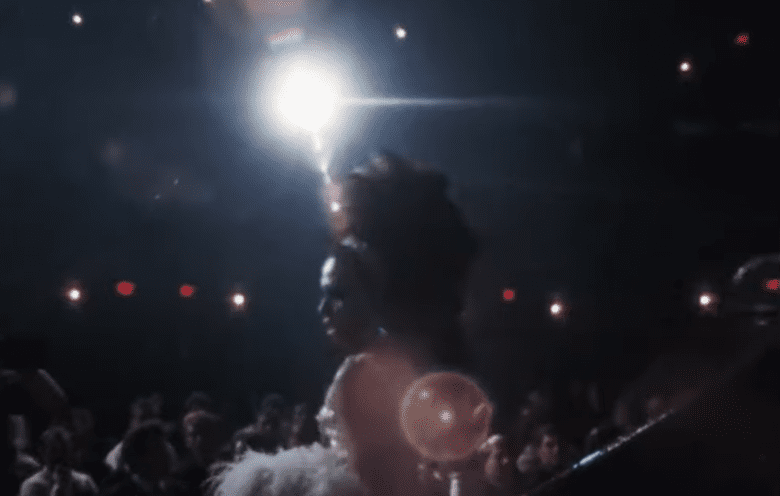
Crystal LaBeija performs one final pose as the lights shine on her at the Miss All-America Camp Beauty Pageant. (Source)
The house system in drag culture was a necessity for queer people, particularly in the 70s, 80s, and 90s. It typically consisted of a “mother,” the leader of the house and main financier of drag balls and other events, and “children” who were also drag queens or queer people that lived in the house. The house system sought to emulate famous fashion houses of the time, like Chanel and St. Laurent, and embraced the fabulous lifestyles that many queens aimed for. It brought together LGBTQ+ people from different walks of life, including drag queens, gay men, transgender people, and sometimes straight women.
Importance of House System in LGBTQ+ Community
It’s no coincidence that rising popularity of all-Black and all-Latino houses coincided with the rise of the Civil Rights Movement and Gay Liberation Movement. Queer people of color recognized the importance of finding community and organizing themselves to combat anti-gay, anti-trans, and anti-drag sentiment that permeated much of the society around them.
Houses like the House of LaBeija provided a chosen family for individuals in the LGBTQ+ community who had been shunned or otherwise excluded by their blood relatives. They offered protection, acceptance, and support at a time when laws were passed to criminalize their identities and authorities routinely harassed patrons of gay bars and drag events.
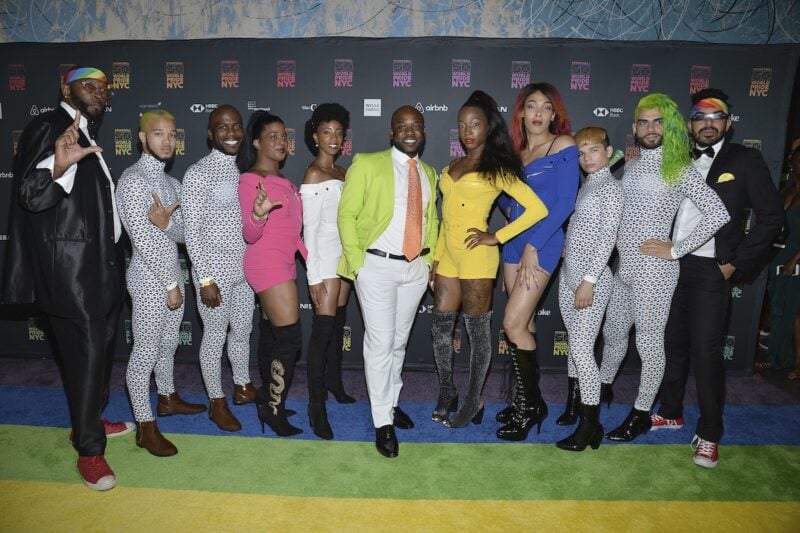
House of LaBeija attend the WorldPride Opening Ceremony Benefit Concert at the Barclays Center in Brooklyn, NY on June 26, 2019. (Photo by Anthony Behar/Sipa USA)(Sipa via AP Images)
Moreover, Marsha P. Johnson, Sylvia Rivera, and Zazu Nova were at the forefront of the Stonewall Riots just a couple years before these houses were created, and their efforts further cemented the notion that drag, transgender, and queer culture wasn’t going anywhere. Crystal LaBejia’s house became one of the most prominent in Harlem, and hers along with the House of Xtravaganza, the first Latinx house, and others became known as “The Terrible Five.”
Pepper LaBeija Takes Over as House Mother
A couple of years after establishing the House of LaBeija, Crystal passed the torch to one of her “children,” a drag queen named Pepper LaBeija. Pepper served as the house’s mother for the next 30 years. The house continued the tradition of hosting drag balls and offering community support, and became heavily involved with AIDS activism throughout the 1980s and 1990s.
True to form, Pepper LaBeija carried the tradition of sass and shade that Crystal embraced while she competed. When a pageant judge told Pepper LaBeija that her physical features were too ‘negroid,’ she responded, “That’s alright, I have white eyes.”
- More stories: How Lani Ka’ahumanu Pushed For Bisexual Visibility in the U.S.
- More stories: Reckless Eyeballing: How Matt Ingram’s Story Reveals Fear of Black Sexuality
- More stories: Why Is Bisexuality an Invisible Majority in the LGBTQ Community?
Crystal LaBeija’s Death and Legacy
Not much is known about Crystal LaBeija’s final years. Rolling Stone reported that she died in 1982 from liver failure, but the official House of LaBeija website contends her death occurred in the mid-1990s. LaBeija’s death was caused by from organ failure, most likely influenced by an overuse of hormones, which were largely unregulated at the time.
Today, Crystal LaBeija’s legacy lives on. Beyond establishing the House of LaBeija and forming the house system in Harlem, LaBeija continues to have an impact on the queer community. For example, a fellowship called the Crystal LaBeija Organizing Fellowship aims to support transgender, gender non-conforming, and non-binary people of color in the U.S. who are a part of the house ball scene.
In arts and culture, bi+ musical artist Frank Ocean samples her “because you’re beautiful and you’re young” quote to Rachel Harlow in a 12-second track called “Ambiance 001.” Perhaps most impactful though, was Crystal LaBeija’s influence on world-famous drag queen and television personality, RuPaul Andre Charles.
RuPaul’s first experience in seeing a drag show was watching Crystal LaBeija on stage in the late 1970s. She wore fishnets and a black bustier while lip syncing to a Donna Summer song. He went on to become a drag queen and later produce and star in RuPaul’s Drag Race, a reality show for competing drag queens that spanned 15 seasons and won 7 consecutive Emmy Awards.
The ballroom scene continues today, with major hubs in New York City, Baltimore, Philadelphia, Atlanta, and other cities along the East Coast. Decades after LaBeija’s death, ballroom culture is still enjoyed by myriad of participants from different sexual and gender identities, races, and ethnicities. The universal necessity of finding a chosen family and embracing one’s community that Black and Latinx drag queens yearned for in the late 20th century marches on today. And as more anti-drag, anti-transgender, and anti-gay laws are passed by American lawmakers 100 years after the ballroom scene’s renaissance in 1920s Harlem, these roots in queer culture remain as relevant now as they were back then.
- More stories: Corporations Embolden Hate When They Cave to Anti-LGBTQ Fury
- More stories: What Daughters of Bilitis Achieved for Lesbian Rights
- More stories: How the Hatpin Panic Changed 20th Century Gender Politics







Loved every word. Keep
Shining the light on hate!
Loved every word. Keep
Shining the light on hate!
Love any mention of this famous moment but Crystal’s statement backstage is incorrectly captured here.
She says, “It’s only publicity and it’s bad publicity for Harlow and all the rest because I declare her one of the uglier people of the world!”
Not Harlem and certainly not declaring herself ugly.
Not Crystal darling!!
Thank you for pointing this out! I probably listened to this quote a dozen times and really struggled to figure out what Crystal said. The video recording equipment that’s 50+ years old coupled with a fellow queen yelling at the same time made it so tricky to determine exactly what’s said here, but I think you’re right. I listened a few more times and found another good source that quotes this line as well, so I’ve made the change to the article. Thanks so much!